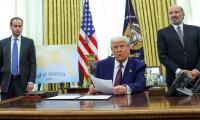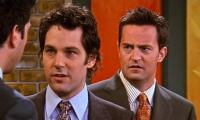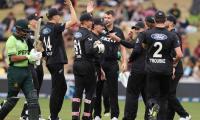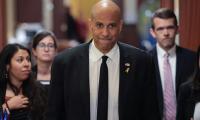Nawaz Sharif wants a third incarnation in a country where one life is too many for an elected prime minister. In his third life, he wants to change the rules of the game once and for all. His confidence is based on an accomplishment he achieved in 2007 when he returned from the land of the dead, claimed his throne back and chased his tormentor out of the country. Having reversed a time-honoured ritual, he wants to change the rites of the passage.
All intelligent or grey-haired spectators know the play line by line and scene by scene. However, it retains its charm because it is played with a new caste each time and a good part of spectators are new every time. Each cast brings its own strengths and weaknesses to the theatre. New opportunities do emerge as roles reverse and costumes change hands. New scenarios also take shape because the actors are allowed to improvise and the stage is constantly shuffling. This time, for protagonists we have Nawaz 3.0 and Imran Khan 2.0. Imran in this play is not very different from the original Nawaz Sharif.
Despite his self-destructive tendencies, Nawaz Sharif has eluded complete annihilation so far. Even as a fallen angel, he looms large over the horizon of Pakistan’s politics. Imran Khan has succeeded in taking Pakistan’s politics back to 1990s but he is stumbling while trying to perform Nawaz 1.0.
Sharif’s opponents fail to grasp him because they try to define him in terms of his origins. Origins tell us a lot about a person. But they can often be more misleading that revelatory. This is because humans can transform and transcend their origins. Those who do not change often turn into their own ghosts. Those who are wounded can become healers. In fact, they make the best healers, provided they can rise above their own pain.
Chaudhry Shujaat Hussain in his recent autobiography mocks Nawaz Sharif’s lowly political origins. Chaudhry Sahab tells us about his family’s first encounter with a fair-skinned Kashmiri young man who came knocking on their door one day with the offer of monetary support for the then upcoming elections. The naïve young man did not know perhaps that the Chaudhrys needed no investors. Perhaps it was an attempt to break the ice with a family that was very close to Ziaul Haq. The offer was declined and the young man was returned without the courtesy of a cup of tea.
It was Ziaul Haq, the mentor of the Chaudhrys, who warmed up to the young man and his family. Zia’s own humble origins made him uncomfortable with large agriculturists who boasted family trees going back to the time of Noah. He rather felt happier with self-made industrialists who had been tormented by Bhutto, and so were his [Zia’s] natural allies.
As a politician, Nawaz 1.0 was essentially a successful aggregator of the social and socio-economic groups who feared Bhutto’s return to power. He successfully roped in the traditional elite through an elaborate patronage network of a kind Pakistan had never witnessed before. He served an important purpose by weaning people away from the PPP and Central Punjab was turned into a pro-establishment region after a long time. Since Sharif assumed control of Punjab, the province has remained firmly in the hands of the capitalist classes. However, the division between the different elite groups remains blurred as the traditional elite and children of the salariat have turned into crony capitalists in large numbers.
By the time he was flung out of power in 1999, Nawaz Sharif had already risen above his origins. He was not just an anti-Bhutto figure and aggregator of anti-Bhutto groups but a leader of millions of people and head of a popular political party. By establishing a popular national political party, he had been able to achieve what only Z A Bhutto had done so far.
In 2007, Nawaz Sharif returned to the country as a changed person. His appearance had transformed and his vocabulary had changed. What is worse, he appeared to have lost his anger and the killing instinct he had. For the first time, he fought an election in a non-confrontational mode and gained much of the ground he had lost to the ‘King’s party’, the PML-Q of the Chaudhrys of Gujrat. Unlike Sharif, the Chaudhrys had failed to maintain even a fraction of the glory bestowed upon them by Pervez Musharraf. They had been beaten again by the Kashmiri boy, this time despite the support available to them.
Nawaz Sharif stuck to the Charter of Democracy to a large extent. There was the 18th Amendment and the 7th NFC award and a lot more. However, Nawaz 1.0 kept dragging Nawaz 2.0 back. He supported the excesses of the Chaudhry court and helped the establishment in hauling Asif Ali Zardari over the coals. During his own rule, two different camps pulled the party in two different directions. There was the powerful Chaudhry Nisar who represented Nawaz 1.0 and a host of other impatient leaders who were more like Nawaz 2.1.
Nawaz 2.0 might have been a much transformed figure, but he failed to strengthen democracy through any meaningful process of reforms. He is facing attacks from the holes that were left in the citadel of democracy due to his own attitude. He was reluctant to visit parliament and the court forced him to involve the cabinet in the process of decision-making. Even at the tactical level, he lost the crucial support of the PPP by letting Chaudhry Nisar cheer and claim credit for the accountability process against the PPP. It was this process that made Zardari run away from the country and return as a chastened person, reluctant to support the PML-N.
Nawaz Sharif once again admits his mistakes and wants to change the game altogether. Reincarnated as Nawaz 3.0, he finds himself in the shoes of Mohtarma Benazir Bhutto and he is arrayed, at least politically, against his own past re-cast as Imran Khan. But Imran Khan has been defeated by himself already. While Nawaz Sharif represented the ascendancy of the industrialists and urban business classes as opposed to the rural elite, Imran Khan does not represent any structural shift.
The only structural shift Imran Khan aimed at was the dominance of the middle class in politics, replacing all other types of elite groups. With the incorporation of hordes of electables, the representation of the middle class in the new PTI is hardly better than the other two parties. Imran Khan’s main role is to keep Nawaz Sharif at bay, just as the main job of Nawaz Sharif 1.0 was to keep Bhutto in check. So far, Imran has done his job well.
Nawaz Sharif’s main strength lies in his popular base anchored in the most powerful geographical area of the country. It was he who had weaned Lahore and Central Punjab away from the PPP and made it docile and pro-establishment. Can he turn the region in the opposite direction now? The future is a land of possibilities and Nawaz 3.0 can be as surprising as his earlier versions.
The writer is an anthropologist and development professional.
Email: zaighamkhan@yahoo.com
Twitter: @zaighamkhan
This demand has fueled rapid growth deposit base of Islamic Banks and Islamic Windows operated by conventional banks
But Punjab Agriculture Food and Drug Authority building near Thokar Niazbeg on Multan Road stands out
Macron has been particularly vocal in their criticism, asserting that withholding arms from Kyiv plays directly into...
As PPP governs province, Bilawal Bhutto Zardari holds strategic position to address both violence and its underlying...
Critics argue that strategy is vague, but closer look indicates strategic alignment with global trends and national...
To defeat it, we must distrust bot-driven narratives, to defeat it, we must verify sources before believing or sharing







